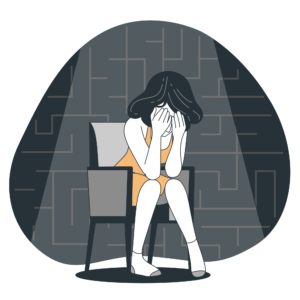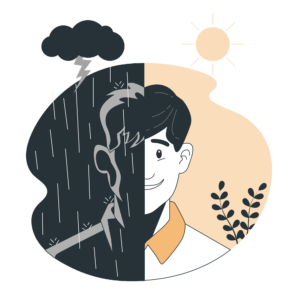BLOG:
MENTAL HEALTH AND
INTERNATIONAL
STUDENTS IN FINLAND
INTRODUCTION
A number of studies have shown that students in higher education are more prone to fall under physical and mental stress. Even though the mental health of university students is superior to that of the general population, depressive symptomatology is higher (Sarmento, 2015). When it comes to the mental health of international students, other stress factors can be identified and are associated with migration and adaptation, making international students more prone to mental health issues.
Although there is a growing interest in the mental health of international students, there is little to no research on the topic.
This blog will thus focus on mental health and high degree students in Finland, bringing closer insights on factors negatively and positively impacting students’ mental health, followed by some resources to ease international students’ adaptation in the Finnish system.
This blog was written by:

CONTEXT
To study in Finland, it is not necessary to have previous knowledge of the local language, as there are over 300 international programmes lectured in English. The programs are mostly interdisciplinary and range from Russian and Eastern European studies to intercultural studies, to high-technology and fine arts.
The number of international degree programmes in Finnish higher education grew exponentially. In 1996, there were approximately 75 international programmes in universities and polytechnics. By 1999 this figure had almost doubled. In December 2010, there were 335 international degree programmes at bachelor’s and master’s level in universities and polytechnics, most of which taught in English. Additionally, in 2018, there were about of 20’273 international students in Finland (Statistics Finland, 2018).
Nowadays, Finland ranks second in Europe after the Netherlands when measuring the share of English taught programmes, whereas first according to the proportion of institutions providing English language programmes (Wächter & Maiworm, 2008).
There are 13 Finnish universities, and they are owned by the state. Their focus lies in scientific research, offering students a more theoretical education. Universities of applied sciences, in turn, are governed by local municipalities and private entities, and are orientated towards developing practical skills and engaging in industry development projects.
POSITIVE ASPECTS
One of the most well-known Finnish features is its educational system. But why does Finland have the best higher education system in the world?
When it comes to studying in Finland, a common idea shared by international students is the well-being and support delivered by the teachers. More than that, the Finnish system is based on independent study and research. For that, the schedules are lighter, balanced with the autonomous studying time, meaning less teaching hours to undertake during the week. On average, the schedule predicts – in one year of full-time study – an equivalent to 1’600 hours of student work (about 60 credits or ECTS). In most cases, one credit accounts for ~25 to 30 working hours, depending on the courses offered by the different departments and the amount of credits offered.
Another positive feature is that, due to the structure of the Finnish university system, students are relatively free to determine the pace and direction of their courses of study. Many lectures may be completed by readings and examinations on prescribed books instead of lecture attendance. Some lectures do not have final examinations at all, but require the completion of exercises and often regular or compulsory attendance. The university promotes teaching for all students and believes that a single exam will not define one’s learning as we all have different learning approaches. Additionally, the teaching methods may vary a lot. Different lecturers can offer different examination approaches: take-home examinations, writing brief research papers, lecture diaries, or summary reviews instead of formal examinations. Oral examinations are rare in the Finnish system, for example. Moreover, examinations may be retaken several times. If a student fails an examination, or is otherwise not satisfied with the grade, the examination can usually be retaken on dates set by the examiner. The teachers are, thus, very flexible; the examination dates or paper deliveries can always be discussed between students and teachers as the main priority is that the students learn, acquire, and pass the course. The examination options are wide and “personalised”, as they are adapted according to each student’s learning needs and availability.
Even at the bachelor’s level, students are responsible for their own study plans, and have a high degree of flexibility when it comes to planning their exam dates, facilitated by the teachers who strive for students’ learning, success and good mental health. Being an international student from the South of Europe myself, I found the amount of lecture hours and openness from the teachers very soothing and encouraging, as we had more free time and support for our independent study, compared to what we would have back home.
Finland does not only boost quality education, but also offers a free education system, which applies to Finnish Citizens as well as students coming from EU/EEA countries and Switzerland. The Finnish system considers education as an equal right for everyone. In addition, students are eligible for financial aid (as in Finland, students are actually paid to study!) and study grants. In the case of PhD students, there is a portal where they can apply for grants and funding for their research (https://www.researchprofessional.com/sso/login?service=https://www.researchprofessional.com/0/).
The Finnish educational system has a lot going in its favour. It is largely based on investment, development and research and the facilities of both universities and polytechnics benefit from these policies on all levels. A good example to mention are the faculties’ libraries. Offering a wide bibliographic selection, the book renting is free of charge for all as well as the access to internet services. More than an academic establishment, I consider these buildings astonishing pieces of architecture from the exterior to the interior – which offers the most comfortable and well-organised spaces for all necessities: meeting rooms, silent rooms, common spaces, relaxing corners, and so on.
Moving on to the cost of living, needless to say, Finland has one of the highest in Europe. In contrast, it offers its students a lot of financial support, housing subsidies and discounts. As a student, although not paying for university, you are advised to pay a membership fee for your student’s organisation. This comes with many offers as your money will be topped up after one month through all the discounts that vary from economic meals to public transports, to health care and other support services. The public transport goes from 65 EUR to 35 EUR, translating to a 46% student discount. The same applies to the university cafeteria – Uni Café – which deserves a mention, as it offers not only good student discounts on meals but also good quality food. Even if not on the app (Frank App), or your university card, some coffee shops, stores, bars, and even second-hand stores have additional offers for students. The only thing to remember is to ask for it, as they will not say it to you upfront. A trick for living in Finland is to look for second-hand shops. Some that I could recommend as a student would be: UFF, Goodwill, Reuse and Fida as second-hand clothing chains which sell all types of things needed from clothing to house utensils.
One feature that highly impressed me in Finland, was its offers on vegetarian and vegan options. Before moving, I was a true meat lover and I did not really like vegetarian or vegan food. Here, although the meat prices helped in my decision of cutting on meat, the city seems to promote and ease this transition to meatless meals. From student organisation’s events and Uni café, to supermarkets, the non-meat options are wide and taken as the first choice by many people. In most cases, these options are not only cheaper (like in Uni Café, for example), but also taste better. In times where environmental discussions are growing, Finland appeared to me as the perfect place to start a more conscious approach on the way we take sustainability and climate disruption. That is something I will definitely take home. The whole community makes you very conscious about your footsteps and actions as they all contribute to improving the situation.
Moving on, safety here is a feature that cannot go unnoticed. Especially as a woman, it is tranquilising to know that I can go home alone after a night out without having to look out for myself. I am not one to be afraid easily, but from my one-year experience in Finland, I can proudly and emphatically say that the peaceful environment I lived in this country, especially Helsinki where I have resided, is captivating. In Finland, gender and societal equality are highly promoted.
When thinking about public transports I could not have had a better experience. Apart from the great student price, I would consider the single ticket expensive (2,80 EUR), but still, it can be used in all transports for 80 minutes (buses, trams, trains, metro, boats etc). The transport options are wide and, living in the centre, moving around seemed always very easy. From the trams to the train, the metro and the buses, the public transports are very well organised and easy to find. The metro has only two lines, which makes it super easy to follow but, I thought it was the one kept in lower conditions (especially the older metro stations). Even so, the trains were heated in the winter which made the experience so good, and most buses and trains come with charging plugs for your devices, which always comes handy.
NEGATIVE ASPECTS
Starting from the same point as the previous chapter, it is easy to understand why Finnish education system can be considered one of the best in the world, even for international comers. Still, I would consider the system to be rather too complying. From my experience, the periods did not work so well and 3 lectures (from 1 to 3h) or so per class are not enough. From someone that comes from a country where lectures are developed throughout a whole semester, to be given a deeper knowledge on the matter, over such a short time seemed too dry. I was left with the feeling of learning a little bit of everything and a little bit of nothing. A general discussion among my international peers was how we had too much free time and too less content-based lectures, a feeling of not learning enough or as much as back home. Do not take me wrong, the schedule-balance and the relief during these periods was very comforting and, if you are a researcher this is the study place for you. But I was not fond of the opinion-based papers (like the learning diaries), its informality and the approach to run over a topic because there was no time left to deepen it, as it was left to our own charge. Needless to say, this is a matter of adaptation and personal preference.
Taking on the economical matter, as said before, when moving here one needs to keep in mind the living costs. There are always ways to go around the high prices, but alcohol is the most challenging as its purchase-sale is run by the state and highly taxed to discourage alcohol consumption.
From my year living here, I was lucky enough to have never experienced any type of attack. Finland is a very safe country in general but, there are some silent problems that they never tell you about the country before coming here. That would be that in Finland there is still racism and xenophobia. Although it will not come across as obvious, immigrants and foreigners are left in the margins, and the less Finnish you speak the harder it is to get proper service and support in the country. More to that, Finland has big utter problems with alcohol and substance abuse. Most violent crimes happen while drunk, and the victim is also often intoxicated. There are some violent crimes, even racial crimes, but I think it is not as common or at least not as openly spoken.
As an immigrant or just a foreigner, one place where you can feel this mistreatment is in the tricky public health care system. Finland is known for having one of the best health care systems. The private health care is known here for its quality, nonetheless, the public health care leaves a lot to desire. As I came to learn in my experience and discussions among both internationals and residents here, either you have the private health care insurance (often paid by the employer in Finland), which is expensive as you have pay upfront but provides you an immediate and attentive care, or you rely on the public health care which is free but offers an average-quality service and with long waiting times. To add up, it is important to take note that it is, in most times, better to try to book an appointment rather than trying the emergency point.
One solution to the problem is already said then: go to private health care. Another solution would be, along with the HYY membership fee (Helsingin yliopiston ylioppilaskunta), to pay for the Finnish Student Health Service (FSHS – fee mandatory for local students). This system is not collected as part of the Student Union’s membership fee. Instead, all students entitled to use the services are responsible for making the payment for each academic term themselves in Kela’s e-service and it has an extra cost of €35,80 per academic term. For more information on this matter, you can also find the HYY website, under the guide on ‘Health and Wellbeing’.
Another characteristic that cannot go unheeded is the dark winter in Finland. The sun starts rising late and setting as early as 3PM in Helsinki. However, in some parts of Finland, for this period, it does not even rise at all, affecting one’s mental health leading to depressive states, adding that to the cold weather already conditioned.
But do not take it too seriously. Winter in Finland can also be a happy time and there are many suggestions to keep it like that. For me and most international students it was one of the happiest times. For this, one easy solution, highly recommended, especially to those not used to the Nordic weather would be to take vitamin D supplements to help improve/protect your mood and your immune system. More to that, it is always good to keep a positive attitude and a routine. Helsinki, for instance, is full of indoor sports spaces, whether for playing tennis, football, or swimming, among others. The possibilities are unlimited. Besides, I was taught by a Finnish friend how you can, at least within the city, move around the whole time through inside spaces, you just have to discover the tunnels and ways through the metro and its tunnel connections. Still, I would always recommend trying to go outside and enjoy the beautiful white snow that covers the city, while you have it. Go grab a hot chocolate by the fire, at café Regatta. Enjoy!
What is more, this is the season for the snow activities. In Helsinki you can also go ice skating as a variety of rings are set across the city. Many of these are free of charge. Within a time space of 20 minutes from Helsinki, you can start snowboarding, skiing or even try cross-country skiing – a Finnish favourite. If you would like bigger slopes, the North is yours to discover, and the slope options are multiple. The card you buy for the slope stations can be used all over the Nordic countries, as I was told and, in some places, you can even get a student discount from your ESN card (Erasmus Student Network).
The wintertime in Lapland is a must and it will show you the beauty of the “dark times”, as where there is dark, there is also light, and the North offers a variety of them, with the “Northern Lights”. Another remark: one cannot forget that Finland is the land of Santa Clause, so the Christmas time could not be more well fitted. Though the Helsinki Christmas market is still good, the Christmas markets in Finland were quite small and closed before Christmas, disappointing me. However, with a one hour ferry ride you can visit Tallin’s Christmas market which is open on Christmas and was named the Best Christmas Market in Europe in 2019 with festivities and stalls in the Old Town Square.
It is in the winter times mostly, but not only, that there is a common growing sense of loneliness among students in Finland. Especially in the time of COVID and these transitioning times, with Zoom sessions, 1) most classes are still lectured online and 2) no one turns their camera on.
More than that, one topic in which international students pointed out in a survey conducted by HYY (2019) among PhD students as an issue was the lack of community sense, contrasting the overall view presented before. One of the perceived sources of stress was the lack of supportive networks. Influential aspects of social inclusion at the university (e.g., information circulation, knowledge sharing, and project participation) were not always present, and participants reported a sense of loneliness in their doctoral training experience. Doctoral students experiencing stress and loneliness are more likely to face burnout and attrition (Cornér et al. 2017; Pyhältö et al. 2015). Research in Finland indicates that the percentage of doctoral students feeling outside a scholarly community is high and equal 30%. Although stressed among PhD students, it came as an overall feeling for many international students living in Finland.
“Supportive social networks, discussed by all participants, involved the academic culture, and lack of social and academic support from colleagues, supervisors, and peers. While autonomy over their studies was valued by the participants (6/11), most participants (10/11) remarked on the loneliness features here and the lack of “community as such within which you can really learn”.” (HYY 2019)
In the survey conducted by HYY (2019), working life connections were also highlighted as the most frequent issue. Finding a shift-job or a part-time job in Finland comes as quite hard, especially if you do not speak any Finnish or Swedish. It took me months to find the right places to look for it as no one could provide me with the right information.
It is true that to find internships or jobs of any kind, the university introduces “JobTeaser”. You just need to log-in into the platform with your student credentials and start applying. When it comes to finding shift-jobs the matter is different. Even so, in Finland you can find them easily and, for international visitors, in apps like “eesy” and “Treamer” (I used Treamer and I can recommend it). In both, you can find a variety of offers in terms of jobs and places.
There is a lack of communication between the student services and the students themselves and, on the same survey, the organisation came to conclude that it could be nothing but positive for the HYY to develop and provide more employment-promoting services, for example. Sad to say, the communication problems go beyond job information.
“Few people would mention that they had received information about various funding opportunities from the Student Union. Similarly, few students mentioned the university’s student counselling as their source of information on financial matters.” (HYY 2019)
This takes us to another feature, the people, and the culture.
Finnish people are educated and nice but they are shy and very closed, especially in the winter times. Finns tend to have their own groups from school, and it becomes hard to create real bonding. The cultural differences between the Finns and the Southern Europeans are many, but you should also come open-minded to their own cultural ways. One point in which I found we crashed for example, was the social approach. As for us it is natural to be outspoken, loud, opinionated, for them it is rude to be “making noise” on public transports and one of their worst fears is to be caught in a small talk on the street. They also do not have the cultural idea of joint dinners, but then again, it also depends on the person.
Not all Finns are closed, as I was lucky enough to have met some welcoming and warm residents too.
All in all, like everywhere, you just have to adapt and try. You can find all types of people in Finland. Maybe you will be lucky enough to find just the right ones and create a friendship bond.
ALL IN ALL
In case you have problems finding any information, you have access to many resources. Migri.fi platform has all information regarding moving to Finland. In the case of financial support and grants you can always turn to Kela for more information, as they are responsible for that. Moreover, HYY should be able to provide you with all answers to your doubts on their website and, more to the point, as a member of the student union, you should be able to receive all the pivotal information prior to your moving. You can always find their contacts and office point on the website.
In any case, you can always turn to SAMHA. SAMHA is a non-governmental organisation that works in mental health and substance abuse but they also give legal/bureaucratic advice and information on one individual’s rights in the Finland to help ease the moving and adaptation to this “new world’, not only regarding information on legal rights and government support, but also on mental health.


CONCLUSIONS
Most Nordic countries are known for their academic excellence and one-of-a-kind culture, and Finland is no exception. Not only is it a top-notch study abroad destination for anyone looking for a unique Nordic experience, it is also home to some of the best universities in Europe today and has once again been named the happiest country in the world in 2019, which we demystified already.
Wellbeing is a prerequisite for all human activity, including studying. Regularly charting student wellbeing is thus of utmost importance in order to help support students’ study ability efficiently as well as preventively, and international students should not be left out.
There is no doubting the fact that studying abroad comes with a wide range of mixed feelings. For most people, these emotions may come in the form of amusement, anxiety, appreciation, satisfaction, fear, nostalgia or sadness. The idea of going to study abroad can be overwhelming, particularly with the daunting reality of leaving home, friends and relations for an unknown society but have no fear and embrace the new culture openly.
Remember: it can always get better, the first step is yours!
SAMHA RY is here for you. If you need someone to talk to, to listen, and who can help you get better-contact us today.
If you need help don’t hesitate to contact us right away. We are available Monday-Thursday 10-16.00 for an appointment, reserve an appointment online, or contact us via Whatsapp, Phone call, email, or social media.










